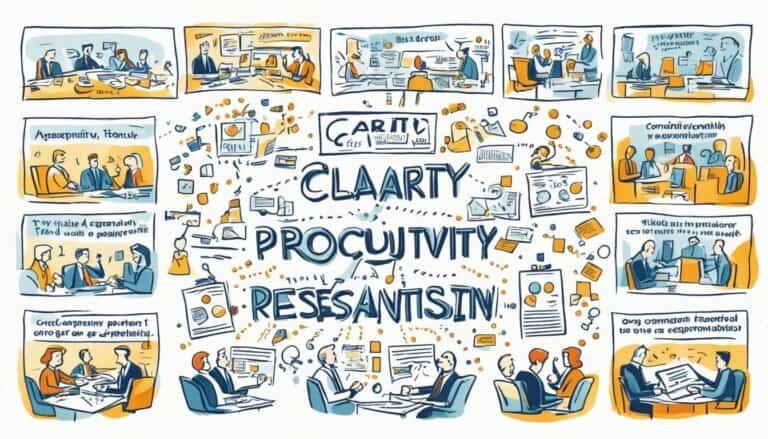What Is Problem-Solving?
Have you ever pondered the immense power behind the art of problem-solving?
It's not just about finding solutions; it's a skill that permeates every facet of your existence.
From steering personal challenges to excelling in your professional endeavors, problem-solving is the key to opening a world of opportunities.
But what exactly does it entail, and how can you master this essential skill to conquer the hurdles that come your way?
Let's explore the depths of problem-solving together.
Key Takeaways
- Problem-solving is a systematic process for identifying and implementing solutions effectively.
- It is a vital skill for success in personal and professional life, nurturing critical thinking and decision-making.
- Effective problem-solvers exhibit characteristics like critical thinking, creativity, and adaptability.
- Techniques like mind mapping, SWOT analysis, and brainstorming increase solution options and aid in problem-solving.
Definition of Problem-Solving
To understand problem-solving, it's essential to grasp its fundamental concept as the systematic process of identifying and implementing solutions to overcome challenges. Problem-solving strategies are vital in *navigating* obstacles effectively.
These strategies encompass a range of problem-solving techniques that individuals can employ to address various issues they encounter. When faced with a problem, it's important to approach it with a clear and logical mindset.
Utilizing problem-solving techniques such as breaking down the issue into smaller parts, brainstorming potential solutions, and evaluating the best course of action can *significantly* enhance your problem-solving abilities.
By incorporating structured approaches like the use of algorithms or heuristics, individuals can streamline their problem-solving process and arrive at solutions more efficiently.
Understanding and implementing diverse problem-solving strategies not only aids in overcoming challenges but also fosters a proactive and resilient mindset essential for personal and professional growth.
Importance of Problem-Solving
The ability to effectively solve problems is a key skill that underpins success in personal and professional endeavors. Problem-solving is essential as it nurtures critical thinking and decision-making skills, enabling you to navigate challenges confidently and make informed choices.
- Critical Thinking: Problem-solving requires you to analyze situations, identify patterns, and evaluate possible solutions. This process enhances your critical thinking abilities, allowing you to approach problems from different perspectives and generate innovative ideas.
- Decision Making: Through problem-solving, you practice making decisions based on available information, considering potential outcomes, and weighing alternatives. This skill translates beyond individual problems, empowering you to make sound decisions in various aspects of your life.
Problem-Solving in Personal Life
Handling personal challenges requires effective problem-solving skills, allowing individuals to adapt, grow, and thrive in various aspects of their lives. When faced with personal dilemmas, employing suitable problem-solving strategies is essential for personal growth. Critical thinking and decision-making play pivotal roles in maneuvering through life's complexities. By honing these skills, you can approach challenges with a structured mindset, leading to improved outcomes and personal development.
In your personal life, problem-solving is a continuous process that empowers you to overcome obstacles efficiently. Whether it's managing relationships, dealing with unexpected setbacks, or pursuing personal goals, the ability to think critically and make sound decisions is invaluable. By analyzing situations, evaluating options, and taking decisive actions, you can enhance your problem-solving skills and achieve positive results.
Effective problem-solving in personal life not only resolves immediate issues but also fosters resilience and self-confidence. Each problem tackled serves as an opportunity for learning and growth, shaping you into a more adaptable and empowered individual. Embrace problem-solving as a means to maneuver life's challenges, promote personal development, and enhance your overall well-being.
Problem-Solving in Professional Life
Exploring the complexities of the professional world demands adept problem-solving skills to overcome challenges and drive success. In your professional life, honing critical thinking and decision-making abilities is important to navigate through various obstacles efficiently.
Additionally, mastering conflict resolution strategies is vital for maintaining a harmonious work environment and fostering positive relationships with colleagues.
Collaborating effectively within a team is another key aspect of problem-solving in the professional domain, as it allows for the pooling of diverse perspectives and skills to address complex issues.
Characteristics of Effective Problem-Solvers
Operating through complex challenges requires a blend of critical thinking, decision-making prowess, and effective conflict resolution strategies. Successful problem-solvers exhibit specific characteristics that set them apart. Here are some key traits that effective problem-solvers possess:
| Characteristics | Description | Importance |
|---|---|---|
| Critical Thinking | Ability to analyze situations, identify key problems, and develop solutions. | Essential for understanding root causes. |
| Creative Solutions | Capacity to think outside the box and generate innovative ideas. | Helps in finding unique and effective fixes. |
| Emotional Intelligence | Skill to manage emotions, empathize with others, and navigate conflicts. | Crucial for effective communication and teamwork. |
| Adaptability | Flexibility to adjust strategies, learn from failures, and embrace change. | Enables resilience and continuous improvement. |
Steps of the Problem-Solving Process
When tackling problems, the first step is to clearly identify the issue at hand.
Once you have a clear understanding of the problem, the next step is to brainstorm possible solutions.
Identify Problem Clearly
To guarantee successful problem-solving, it's crucial to clearly identify the issue at hand by breaking it down into its fundamental components. This involves problem identification through root cause analysis to understand the underlying reasons for its existence.
Once the problem is pinpointed, problem clarification is essential to assure a shared understanding among all stakeholders. This step helps in avoiding misunderstandings and aligning everyone towards a common goal.
Following this, solution brainstorming comes into play, where various potential resolutions are explored. This creative process opens up possibilities and allows for innovative approaches to tackling the identified issue effectively.
Clear problem identification, thorough root cause analysis, precise problem clarification, and creative solution brainstorming are critical elements in the problem-solving journey.
Brainstorm Possible Solutions
Brainstorming potential solutions is an essential step in the problem-solving process, facilitating the exploration of diverse options to effectively address the identified issue. Critical thinking plays a key role in this phase, encouraging you to evaluate each solution's feasibility and potential outcomes. Engaging in collaborative problem-solving enhances the brainstorming process by incorporating different perspectives and ideas, leading to more creative solutions. Decision making during this stage involves weighing the pros and cons of each proposed solution, considering factors such as feasibility, cost, and impact. The table below illustrates how brainstorming can lead to innovative solutions through a collaborative and analytical approach.
| Pros | Cons |
|---|---|
| Encourages creativity | Potential time constraints |
| Diverse perspectives | Risk of groupthink |
| Increased solution options | Difficulty in prioritizing |
| Fosters teamwork | Conflict of opinions |
| Enhances critical thinking | Unequal participation |
Tools for Enhancing Problem-Solving Skills
Utilizing a variety of effective tools can greatly enhance your problem-solving skills across a range of challenges and scenarios. When faced with intricate problems, having the right strategies at your disposal can make a significant difference in finding innovative solutions.
Here are three key tools to enhance your problem-solving skills:
- Mind Mapping: Mind mapping is a visual technique that can help you organize thoughts, ideas, and information in a structured way. By creating a mind map, you can identify connections between different elements of the problem, leading to a deeper understanding and potential solutions.
- SWOT Analysis: Conducting a SWOT (Strengths, Weaknesses, Opportunities, Threats) analysis can assist in evaluating the internal and external factors influencing a problem. This tool enables you to assess the current situation objectively, identify potential obstacles, and leverage strengths to overcome challenges effectively.
- Design Thinking: Design thinking is a human-centered approach that emphasizes empathy, ideation, and prototyping to generate creative solutions. By engaging in design thinking processes, you can foster innovation and develop practical, user-centric strategies to address problems thoroughly.
Real-World Examples of Problem-Solving
When faced with real-world challenges, practical problem-solving strategies can be your guiding light.
By employing effective problem-solving techniques, you can navigate complex situations with confidence and efficiency.
Let's explore how these points can be applied in various scenarios to overcome obstacles and achieve success.
Practical Problem-Solving Strategies
Looking at how successful individuals tackle real-world problems can provide valuable insights into effective problem-solving strategies. When dealing with practical issues, incorporating critical thinking and decision-making skills is essential.
Here are some practical problem-solving strategies to take into account:
- Brainstorming: Generate a variety of potential solutions to the problem without judgment.
- Breaking Down the Problem: Divide the issue into smaller, more manageable parts to identify root causes.
- Seeking Feedback: Consulting others for diverse perspectives can offer new insights and solutions.
Effective Problem-Solving Techniques
To effectively tackle complex issues and find innovative solutions, implementing a structured problem-solving approach is essential. Important thinking plays a critical role in analyzing problems from multiple angles, identifying root causes, and devising effective strategies.
When faced with a challenging situation, engaging in systematic decision-making processes can lead to more successful outcomes. Real-world examples demonstrate how individuals or teams apply important thinking to evaluate options, weigh potential risks, and make informed decisions.
Conclusion
As you navigate the maze of life, problem-solving becomes your compass, guiding you through challenges with clarity and purpose.
Like a skilled artisan sculpting a masterpiece from raw clay, you shape solutions with precision and finesse, transforming obstacles into opportunities.
Embrace the power of problem-solving as your beacon of light in the darkness, illuminating the path towards growth and success. Let it be your trusted ally, leading you towards a brighter tomorrow.







